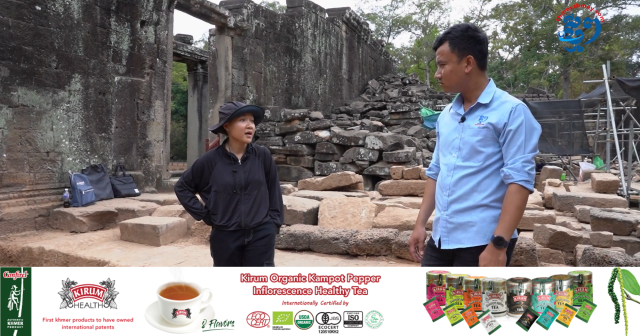The Strategy to Safely Evacuate Rainwater at the Bayon Temple

- By Sem Vanna
- March 2, 2024 6:30 PM
SIEM REAP — After years of facing the elements and human intervention, the drainage systems of temples in the Angkor Archeological Park tend to eventually become dysfunctional, leading to improper water evacuation that may cause the stones to erode quickly and the foundations to weaken.
_1709371324.png)
“There are around 30 main drainage systems here at the Bayon temple, covering the interior and the exterior spaces,” said Meng Sovanlylin, an architect with the APSARA National Authority—the Cambodian government institution managing Angkor Park, which is a UNESCO World Heritage Site spreading over 401 square kilometres.
“However, during rains, only half of the drainage system works. Therefore, the water gets underneath the structure, which should not be,” Sovanlylin said during an interview on Feb 27.
_1709371352.png)
Handling this is a priority in the restoration and maintenance plans of the Bayon, she said. “If the water is not evacuated properly, the foundation soil can become loose, and the water can erode the stones.” As a result, the floor will become weaker, creating more and more weak points toward the pillars, the galleries and so on and so forth, Sovanlylin said.
If the restoration team can keep the drainage system effective, it will considerably help reduce the number of issues in the future, she said.
_1709371386.png)
“Here, we have removed a layer of limestones before reaching this layer of laterite stones” Sovanlylin explained, as she pointed to a specific area. “We will study the soil below and stabilize [the stones] so they serve their purpose.
“In addition, based on our current hypothesis, we predict to find a drainage hole here,” she said, pointing to an area. “If we can find what we are looking for, we might restore this drainage first before moving on to other stages.”
_1709371415.png)
Considered a hydraulic city by hydrologist Hang Peou, who is a director general of APSARA Authority, the city of Angkor relied heavily on water to sustain its agriculture and for the physical stability of the temples.
The Bayon with its famed faces on the four sides of its towers, is the legacy of King Jayavarman VII who reigned during the late 12th century and early 13th centuries. Sitting in the centre of the walled city of Angkor Thom, the Bayon is surrounded by a number of other large temples.
_1709371466.png)
Conducted in Khmer for ThmeyThmey News, the interview was translated by Ky Chamna for Cambodianess.
To watch the original interview in Khmer language, click here.
Related articles:
What Does a Stone Doctor Do at Temples?
Fixing Phnom Bakheng Temple’s Southern Section
Restoring the Ponds of the Temple with the Iconic Faces















